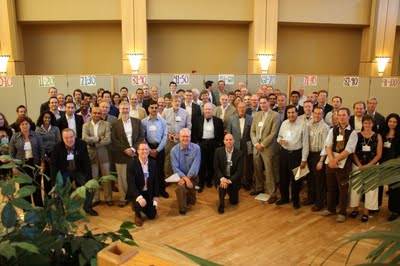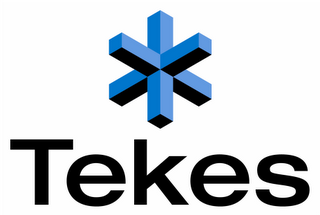
I recently had the great pleasure of being one of the World Economic Forum "Innovation 100" who convened here at Stanford in order to discuss the reasons behind innovative clusters. I will tell you more about the details when the WEF releases its report.
The World Economic Forum Innovation 100 summit is a part of their work on producing an 'Innovation Heatmap' of the world. People have ideas all over the world, but where are the places they are being successful, and what is it with these places that makes it happen just there? Finding the places is not so tricky, once they are successful in innovating - like Silicon Valley. But it is very difficult to nail down a good set of indicators that are useful for benchmarking innovation hot spots, offer a clue of why innovation is going well or not, and that can predict which are the coming hot spots.
So far, the number of registered patents is considered as one of the most important indicators, but it is far from the whole story. Patents can be key in some sectors, like pharma industry, but in other innovation fields like software and services, patents are much less relevant. A few years ago I edited a book that looks at intellectual property issues in the context of commercialization of academic research. It is a complex issue.
There are today lists that rank innovative regions. The European Innovation Scoreboard is one of them. The rankings usually use indicators like those provided in the US Science and Engineering indicators from NSF, or the EU Science and Technology Indicators from Cordis. These indicators are good for assessing things like educational level of workforce, number of registered patents or published research papers - the types of numbers that are possible to measure in surveys or by scanning public registers. They usually miss out on one crucial issue for innovation: mobility. Mobility can be between various professional domains: innovation is not driven by science OR technology OR business OR politics, but by the interaction between them. Mobility is also geographical: Silicon Valley hosts people from all over the world. Even though it seems doable to trace the mobility of people, it is a controversial thing to do - people have the right to privacy. It is also difficult to quantify in an easy way (its much easier with number of patents or math test ratings)
Innovation is often about new combinations of existing concepts, or re-framing something in a new context. In the seventies, very few thought of computers having anything to do with storing pictures, even less music. Bringing artists into the world of computers and vice versa was probably more important for innovation than doubling the number of excellent Cobol programmers (the biggest programming language of that day). At the same time, many innovation scoreboards will care more for programmers than artists, and not think of addressing the communication between them. The people running such scoreboards may have some valid concerns about how to address such issues: how does any measurable quantity relating to artists relate to innovation? Does the number of art galleries scale with innovation? How? How can the innovative interaction between artists and programmers be measured?
I have a hunch that innovation hot spots are more likely to be places with low thresholds between people doing different things, where people easily get to know each other, and where they can easily interact in making novelties happen. I imagine they are places with a high concentration of people that find few things as important as the next big thing, who want to be a part of it, and who like chatting about it with anybody who is interested, regardless of profession or background. In Silicon Valley, it happens that people start companies with people they met at their children's birthday parties.
All this requires one thing: This diversity of people in the innovation ecosystem need to share a language that allows them to chat about the stuff that interests them. Otherwise they will have a tough time sharing interests and adding their own parts to it in a way that other people will understand. Innovation is about the introduction of novelties, which often come with new words and narratives, so I guess I am suggesting that innovation hotspots are more likely to be places where people in the innovation ecosystem can rapidly develop new shared language.
Since a few years back, there are tools on the Internet that can measure the development of language. Google Trends is one entertaining example, it 'charts how often a particular search term is entered relative the total search volume across various regions of the world, and in various languages' (Wikipedia). I think future key innovation indicators can be found through sources like Google or Facebook, finding the hotspots on the geographical world map, as well as the social map, where new language is growing the fastest, also analyzing how the new language connects to market value, weighing these things together.
Today, not many of the people dealing with how we innovate give much conscious thought of how we generate the shared language that is needed for any process of innovation or successful outcome thereof. Sociolinguistics and studies of innovation can be a great pair!
Here are some arguments, linking the thought about language as an innovation indicator back to earlier thoughts posted on this blog:
The formation of new shared language is always a part of innovation.
A concept requires the following language components in order to be shared by people:
- A Name - so that it can be referred to
- A Definition - so that it can be identified
- A Narrative - so that it can be related to and put into context; a narrative is needed to relate a concept to the surroundings and lives of people, to cultures, or to other concepts
- Innovation is the creation and introduction of new customer value to the market
- In order to introduce something, it needs to be communicated
- Communication requires shared language
- New concepts need new names, definitions and narratives to be a part of the language
- The new names and definitions need to be called to peoples attention so that the new things can be discussed and introduced in our language.
- People's attention will influenced by attention workers - professionals who generate and broker peoples attention, such as journalism, PR, marketing or lobbying - who have a stake in innovation. They typically take part in the innovation value chain by acting either in the interest of the sources of new language (PR, Marketing, Lobbying) or in the interest of the audience for new language (journalism). The attention workers of different sorts interact with each other, forming an ecosystem which will be facilitating the formation and introduction of new shared language. It may be referred to as the innovation communication system.
As I said above, innovation is not about science OR technology OR business OR politics, etc. - it is about the connection between them! All involved professional fields have their own language. The concept of 'attention workers' and the 'innovation communication system' introduces incentives and mechanisms for creating shared language between different sectors and professions who come in touch with each other through innovation.
I believe our ability to generate new shared language is one of the bottlenecks for innovation. It is especially challenging to 'bridge verticals'. People in different professions can be talking about the same things without understanding each other, because they have different language for it. Sometimes different specialists don't have words for what other specialists are doing: Most politicians don't understand radioengineering and most radioengineers don't understand political science. Bridging them is an opportunity for attention workers, the key professional group from the societal point of view are the journalists - the attention workers who act in the interest of the readership (PR are attention workers who act in the interest of the sources - they are both needed in the bigger game).

















